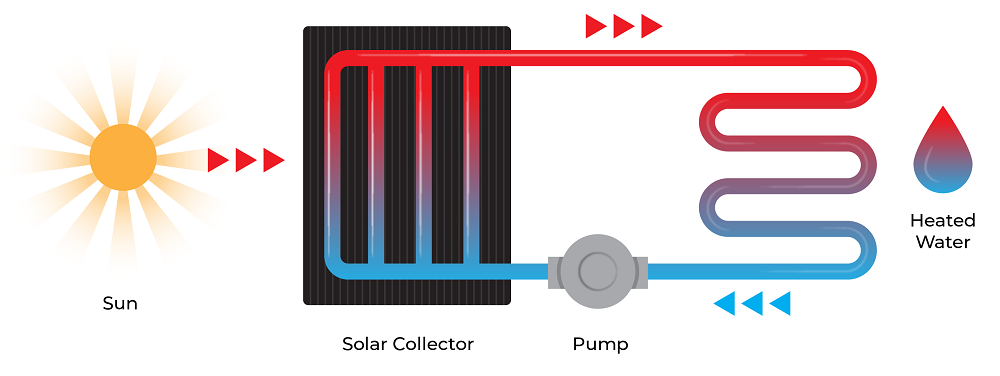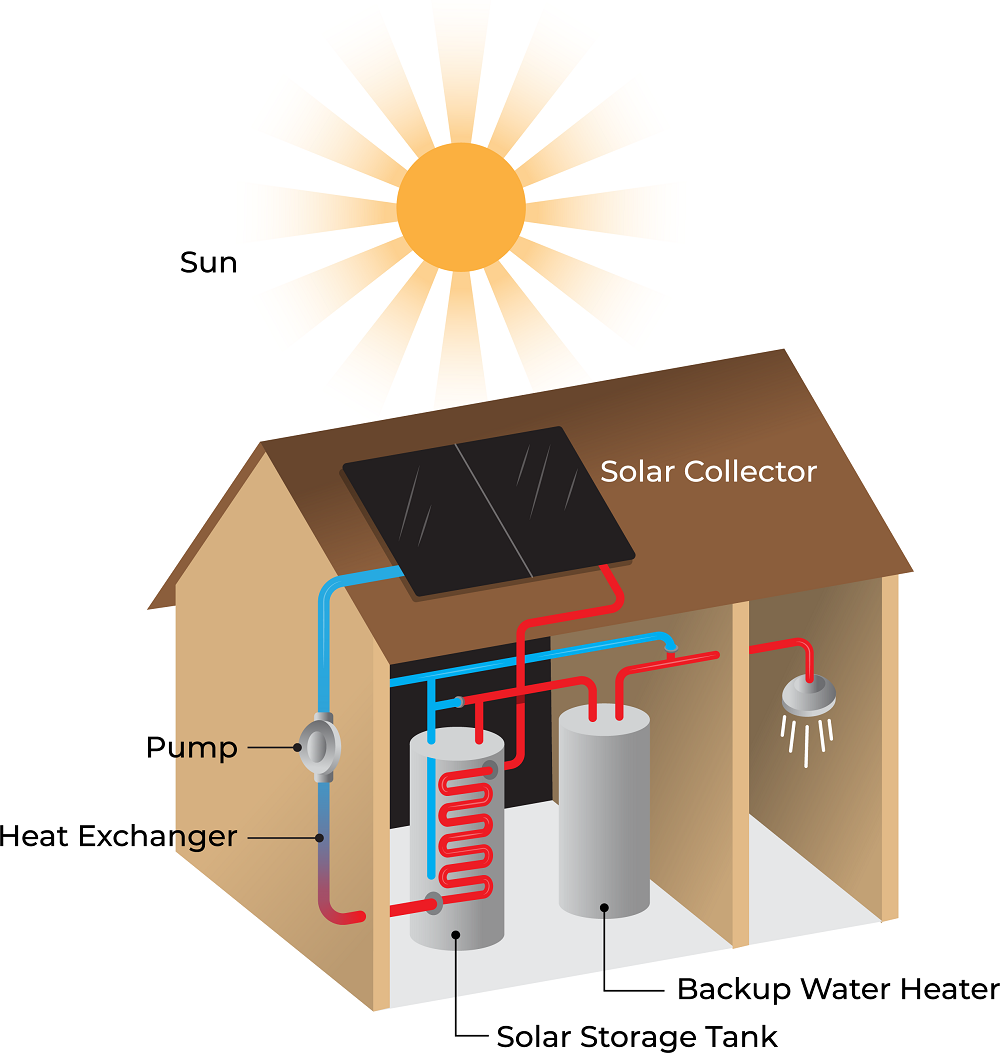ENERGY STAR® Solar Thermal Water Heating System
Receive a $2,500 to $5,000 rebate on ENERGY STAR certified solar thermal systems with a natural gas water heater backup.
Visit socalgas.com/Rebates for details and to apply.
Getting To Know Your Solar Water Heater
Solar water heaters are often confused with solar electric energy generators (such as solar PV panels). Instead of generating electricity, they collect thermal energy from the sun to produce the hot water needed in homes, offices, and even industries. And they do this in a way that is over three times as efficient as PV modules and won’t take up a large amount of space on your roof.
Now that you have a solar water heating system in your home, it is helpful to understand the basic way they work. There are several different types and designs of solar water heaters. But in the end, they all do the following things:
- Collect thermal energy from the sun
- Use the collected solar energy to heat your water
- Store any extra energy for use later when you need it.

And unlike a traditional “off the shelf” water heater, they have a few more parts and pieces that come together when installed in your home. The diagram shows one type of solar water heater common to California, and it works as follows:

- Solar collectors are mounted to the roof, usually oriented toward the south, and tilted to catch the maximum amount of solar energy during the day.
- Pipes making up the solar loop connect the collector to the solar tank, and a pump moves the fluid in a loop. The collector warms the fluid, it is pumped to the solar tank where it heats the water, and then the cooler fluid flows back up to the collector to be reheated.
- The solar storage tank contains the heating heat exchanger and the tap water. For an indirect system like this one, a heat transfer fluid is used that does not mix with your tap water. The heat from the solar loop is transferred to the water through the heat exchanger. A cold water line connects to the solar tank to refill it as you use hot water.
- The water in the solar tank heated by the sun flows into the inlet of the backup water heater as you use hot water. If needed, the backup water heater boosts the water temperature up to the setpoint. But if the water from the solar tank is already warm enough, the backup does not turn on at all. Backup water heaters are there to make sure you always have enough hot water, no matter the weather. (Note: Some solar water heaters may not have separate solar tanks and backup water heaters. These combine the two into a single tank to save space.) Any kind of backup water heater can be used – gas or electric, tank-type, or tankless.
- The whole system is linked by a controller that monitors the temperature of the water in your solar tank and the rate you are using hot water. Most solar water heaters use smart controllers that allow the water in the solar tank to heat well above the setpoint of your water heater. This allows solar water heaters to store as much solar energy as possible during the day to reduce or eliminate the need for the backup heater to run. For example, if your hot water setpoint is 120°F, a solar tank controller may allow the water in the solar tank to heat up to as much as 160°F (depending on the tank) during the day. Once it hits the maximum temperature, the pump turns off. A mixing valve then adjusts the temperature to a safe setpoint as it moves into your plumbing system to avoid scalding risks.
Depending on the geographical location, local weather, time of year, and system type, your solar water heating system can provide all the needed hot water in a household. But when you need it, the backup water heater will turn on from time to time, automatically.
Although solar water heaters may seem more complex than traditional water heaters, they can be easy and reliable to operate. Just follow a few simple guidelines to get the most out of your system:
- All solar water heating systems should be installed by authorized, licensed personnel with the right qualifications and tools.
- Authorized contractor/personnel will setup, test, and commission your new system according to the manufacturer’s installation manual. They should show you how to operate your specific system and what issues or alerts you should watch for.
- Check your water temperature and adjust as necessary to meet your needs. Most manufacturers recommend a set point of 110 – 125°F. Consult your manual to see how to adjust the setpoint.
- If there is a problem with your solar water heater, it will be installed with valves to allow you to bypass it and use the backup water heater alone. Familiarize yourself with the steps required to do this.
- Refer to the manufacturer's user manual for a more detailed operation guide specific to your solar water heating system.
Because solar water heaters work quietly and automatically, homeowners sometimes wonder if their system is working correctly (and giving them all the savings possible). There are several ways you can know that a solar water heating system of the type shown above is working, depending on your type. One or more of the following can show that it is working:
- The pump/pump station is running.
- The flowmeter in the solar loop shows a reading.
- The temperature gage on the solar tank shows an elevated temperature
- Temperature gages on the solar loop show that the fluid coming from the collector is warmer than the fluid entering the collector.
- The controller or connected mobile app shows the current operation and energy savings.
- Your utility bill drops!
Bear in mind that the pump will not operate at all times. Overnight when there is no solar energy, the pump turns off, and it will not restart until the collector heats up again in the morning. Later in the day, the pump may also turn off if the solar tank reaches its maximum temperature. If you check these items and are concerned that the solar water heater is not operating, contact your installer or service provider. Rest assured that even if the solar water heater is not operating as it should, your backup water heater will automatically provide you with the hot water you need.
Like any other water heater, preventive maintenance is necessary for retaining system efficiency and prolonging operating life. Regular inspections are advised as described in the manual for your solar water heater. Typical maintenance includes:
- Clean the collectors as recommended in the user manual. Regular rains should keep the solar collectors clean from most dust and debris. In most cases, it is not necessary to clear snow from collectors. Most collectors are designed to melt away any snow/ice atop the collectors. DO NOT pour water on the collectors. DO NOT try to remove snow and ice with sharp objects to avoid damage to the collectors.
- After extreme weather events, check the collectors and piping for any damage and tighten mounting bolts if necessary. If any damage is found, contact your installer or service provider.
- At least once a year, or in the case of malfunction, the following visual checks should be carried out.
- Pump and overall system operation
- Condition of outdoor piping and insulation
- Solar collectors
- Solar tanks and backup heaters
- If your solar tank or backup heater includes an anode rod, check and replace it as recommended by the manufacturer.
- Periodically check the floor around the solar tank and backup heater for leaks. If a leak or abnormal noise is detected, contact your installer and consider bypassing the solar system.
- Flush the solar tank and backup water heater as recommended in the manufacturer’s operation manual. In coastal areas or areas prone to limescale formation, it may be necessary to flush more often.
- Heat-transfer fluid must be checked at least every three years and changed if necessary (or sooner if required by the manufacturer of your system). Contact your installer for this IMPORTANT maintenance procedure.
Again, follow the maintenance procedures for your specific solar water heaters. And consider setting up a maintenance agreement with a qualified service provider to ensure regular maintenance appropriate to your system. With proper maintenance, most solar water heaters can last 20 years or even more! Your solar system may even outlast your backup water heater.
Solar water heating systems and backup water heaters are usually provided with warranties covering major components and installation. ENERGY STAR® certified solar water heaters have warranties of at least ten years for the solar collector, six years on sealed system, two years for controls, and one year for piping and parts. Please refer to your manual/warranty guide for more information on the warranty for your system and directions on how to file a warranty claim if needed.
